Introduction to Trademarks and Their Importance
Trademark is a genre of intellectual property consisting of emblem, symbols, words, logo or a combination of these things that identifies your goods and services. Trademark is a step forward in protecting brand identity and goodwill by providing unique identity to the trademark owner's business. One look at the trademark, and the consumer connects it with a company. Trademarks protect the quality that the brand stands for and can convey a certain standard and quality of the product in this age of cutthroat competition and sets them apart from their competitors. The bunch of exclusive rights that come with trademark registration is countless. It generates goodwill and reputation in the market that no one can beat. Trademarks are coming as an asset to the trademark owner by opening the doors of substantial revenue generating streams. You can either use your trademark to promote your own business or sell/license the trademark or even use it in raising funds. Trademark is serving as a guard against counterfeiting and fraud and providing legal protection to your brand.
BENEFITS OF TRADEMARK REGISTRATION FOR YOUR BUSINESS
A registered trademark is no less than a secret weapon channelising and engendering the growth of the business. If you are the first person to use a trademark, you acquire some rights to the mark as soon as you start using it to sell goods or services. Registration is not strictly required, but there are several advantages to registering your trademark. In addition, the cost of registering your trademark pales in comparison to the losses you can incur for failing to do so. Here are a few reasons why it's a good idea to register your trademark.
1. Increases business value
- In the era of fragile competitive market every business is running to grab an advantageous positioning in the market and use it to their fullest potential.
- Using a trademark can make your business stand out in the multitude business giants and help your consumers identify you easily.
- A registered trademark along with it brings a bundle of rights to the business.
- Trademarks protect the quality that the brand stands for and can convey a certain standard and quality of the product
2. Nationwide legal notice
- A registered trademark gives constructive notice to the world at large that you are the owner of the trademark and copying the mark may amount to infringement of your Intellectual PropertyRights and you may commence legal against the impugned mark.
- It protects your trademark from getting copied or diluted.
- Furthermore, registration may also help you prevent others from using an Internet domain name that could be confused with yours.
3. Serves as an asset
- A registered trademark can turn out to be a greatest asset for your business.
- A registered trademark is an intangible asset that is valuable for your company.
- Should you ever envision ever selling the company, having a registered trademark may increase the sale price.
- You can also sell or license your trademark and generate revenue from it.
TRADEMARK SEARCH
Trademark registrations and registered trademarks are controlled in India by the Comptroller General of Patent Designs and Trademarks. A trademark search of the trademark database will provide the user with valuable information relating the trademark search query. Trademark searching provide a clear gathered information to the potential applicant about the availability and protectability of the trademark. A trademark search persistently uncovers and identifies other trademarks that have either been registered or used and that your potential trademark may conflict with.
HOW TO DO TRADEMARK SEARCH
To do a trademark search in India, visit the trademark search database using a web browser.
Step 1: Select trademark type form “Search Type”

Keep the “Wordmark” selection from the drop-down list.
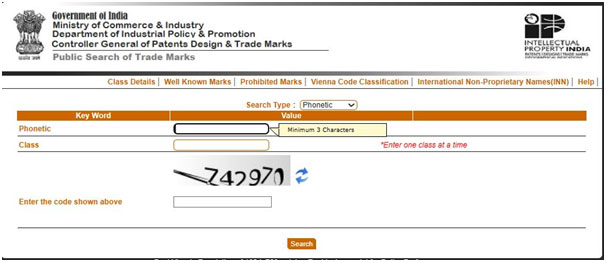
Or keep the “Phonetic” selection from the drop-down list, as per your search category.
Stage 2: Carrying out the Search
- In the first row, at par with wordmark type your brand name in the box next to it.
- In the second row mention the relevant class in which you are seeking search.
- And in third row enter the captcha as shown and proceed to search button.
- The exact result will be displayed on the screen when you proceed towards search button.
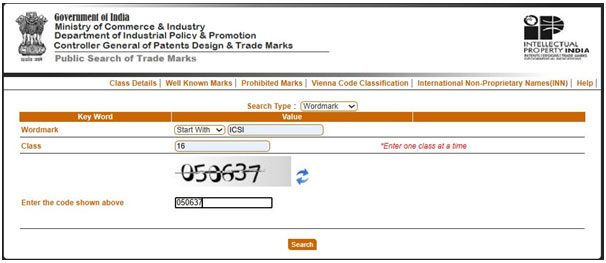
Step 3: Understanding the result obtained
The search result from the data entered in the previous step are listed below.
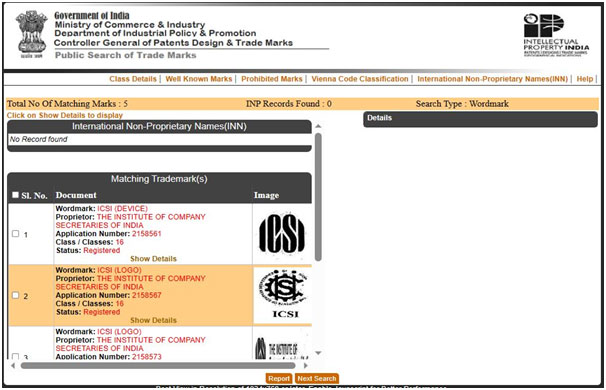
- You can now scroll down to find the different trademarks registered with the said brand name ICSI under class 16. For instance if you have conducted a trademark search for the name “ICSI” and find a similar or existing registered trademark in the records of trademark registry, you are not permitted to file the registration application as it will amount to infringement of Intellectual Property Rights(IPR).
- Through trademark search one can get ample number of information based on the data of search. The “Application date”, “used since” and “valid up to” can be ascertained via trademark search and can turn out to be useful for the applicant.
TRADEMARK REGISTRATION PROCEDURE
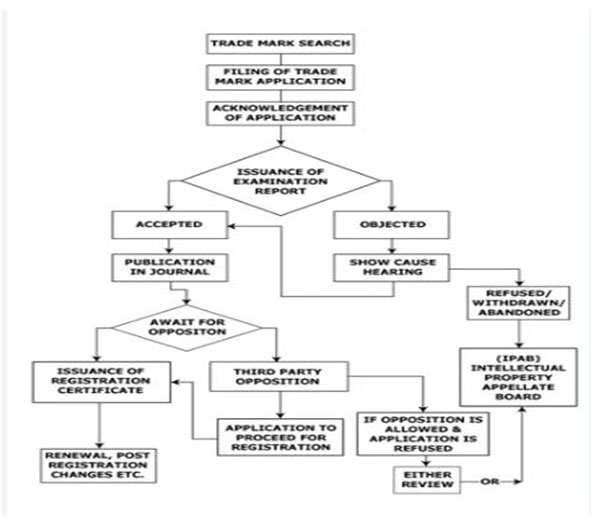
1. Trademark Search
Before beginning the trademark registration process, the entrepreneur or a trademark professional must conduct a trademark search of the trademark database. A trademark search will provide information about identical or similar trademark that has already been filed with the trademark registry.
2. Trademark filling
After trademark search, next step is for filling the application with the registrar. Trademark applications can be filed online by ngandassociates.comor a trademark agent or lawyer.
3. Trademark Application Allotment
Once the Trademark registration application is filed with the Trademark Registrar, a trademark application allotment number is provided within one or two working days.
4. Vienna Codification
Once the trademark registration application is filed, the Trademark Registrar will apply the Vienna Classification to the trademark based on the figurative elements of marks.While this work is in progress, the trademark application status usually reflects as “Sent for Vienna Codification”.
5. Trademark Examination
Once Vienna Codification is completed, the trademark registration application will be allotted to a Trademark Officer in the Trademark Registrar Office.The Trademark Officer would then review the trademark application for authentication and issue a trademark examination report.
6. Trademark Journal Publication
Once the trademark registration application is accepted by the Trademark Registrar, the proposed trademark is published in the Trademark Journal.
7. Trademark Registration
Once there are no objections or oppositions for the trademark registration application, the trademark manuscript and trademark registration certificate will be prepared and sent to the trademark application.
TRADEMARK OPPOSITION
- Grounds of Opposition
- Process of trademark opposition
The grounds on which a person can file opposition for trademark registration are:
a. The trademark is identical or similar to an already existing registered trademark.
b. The trademark is descriptive in nature.
c. The trademark is devoid of distinctive character.
d. The trademark is customary in the present language or the established practices of business.
e. The application for trademark registration is made with bad faith.
f. The trademark is likely to cause confusion or deceive the public.
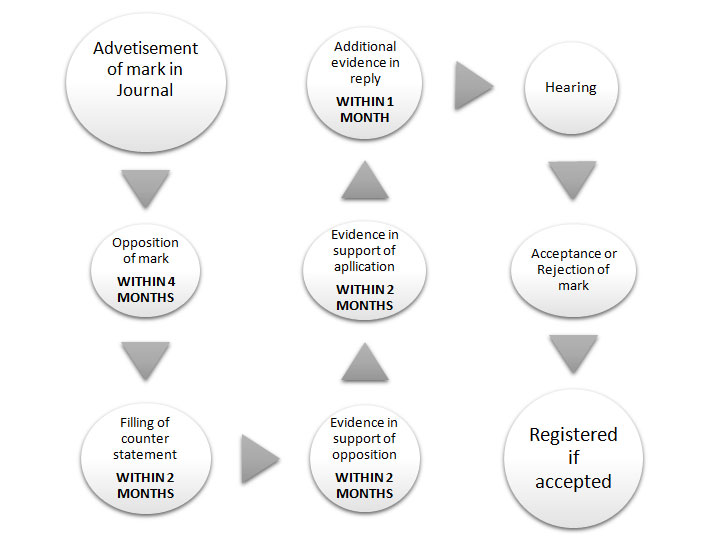
Step 1: Notice of opposition
Any person can file for trademark opposition to the Registrar within four months from the date of advertisement of the registration application in the trademark journal by giving a notice in Form TM-O and payment of fees.
Step 2: Filling of Counter Statement
The applicant must file his/her counterstatement to the notice of opposition to the Registrar in Form TM-O within two months of receiving the copy of the notice of opposition stating his/her facts.
Step 3: Evidence in support of Opposition
The opposing party shall provide evidence supporting his/her notice of opposition under rule 45 to the Registrar in less than two months of getting the copy of the counterstatement filed by the applicant. The opposing party should also send all copies of the evidence to the applicant. Additional evidence can be filled within 1 month.
Step 4: Evidence in support of application
The applicant shall provide evidence supporting his/her notice of application under rule 46 to the Registrar in less than two months of getting the copy of the Evidence in support of opposition under rule 45.Additional evidence can be filled within 1 month.
Step 5: Hearing
The Registrar, after the receipt of evidence by both parties and further evidence of the opposing party, will give notice to both parties of the first date of hearing. If the opposing party is not present on the hearing date, the opposition will be dismissed, and the Registrar will register the trademark.
However, if no conclusion could be drawn from the first hearing the registrar will call for further hearings.
HOW NG & ASSOCIATES CAN HELP YOU
Your trademark application is our responsibility. Starting from public search to dealing with oppositions to renewing your application, we NG & Associates are the one stop solution. NG & Associates adopts a results-oriented approach to provide you an endeavour. A simple and guidance methodology throughout the process is adopted by us to provide you one stop solution to the end. NG & Associates support 100% in advisory, and Guidance with respect to the process.
Here are some frequently asked questions (FAQs) about trademarks:
Q1: What is a trademark?
A: Trademark is a genre of intellectual property consisting of emblem, symbols, words, logo or a combination of these things that identifies your goods and services. Trademark is a step forward in protecting brand identity and goodwill by providing unique identity to the trademark owner's business thereof that represents and distinguishes the source of goods or services from those of others.
Q2: Why should I register a trademark?
A: Registering a trademark provides you with several benefits, including exclusive rights to use the mark, legal protection against infringement, the ability to sue for damages, and a stronger position in disputes.
Q3: How do I choose a strong trademark?
A: A strong trademark is distinctive, unique, and not generic or descriptive. It is recommended to select a mark that is creative, fanciful, arbitrary, or suggestive to increase the chances of obtaining trademark protection.
Q4: What is the difference between a trademark and a copyright?
A: Trademarks protect brand names, logos, and slogans that identify goods or services, while copyrights protect original creative works such as literary, artistic, or musical creations.
Q5: Can I trademark a name or logo myself?
A: Yes, you can file a trademark application yourself. However, it is advisable to consult with a trademark attorney or professional to ensure proper understanding of the process and to maximize your chances of success. And NG & Associates serves the purpose here.
Q6: What is the trademark registration process?
A: The trademark registration process typically involves conducting a search, filing an application with the relevant trademark office, waiting for examination, responding to office actions (if any), and ultimately obtaining registration or facing opposition (if applicable).
Q7: How long does the trademark registration process take?
A: The duration of the trademark registration process varies depending on various other factors. Generally, it can take several months to a few years to obtain a registered trademark.
Q8: Do trademarks have international protection?
A: Trademarks are generally territorial in nature, meaning they provide protection within the country where they are registered.
Q9: What is a trademark search, and why is it important?
A: A trademark search involves checking existing trademarks to determine if there are any similar marks that may cause conflicts or objections during the registration process. It is important to conduct a search to assess the availability and registrability of your desired mark.
Q10: Can I use my trademark before it's registered?
A: Yes, you can use your trademark before it's registered, and in many jurisdictions, common law rights can be established through use. However, obtaining formal registration provides stronger protection and additional rights.
For any consultancy in the Trademark Registration/ Reply/ Opposition ||
Contact 7840071184/ 8505999955/ info@ngandassociates.com

